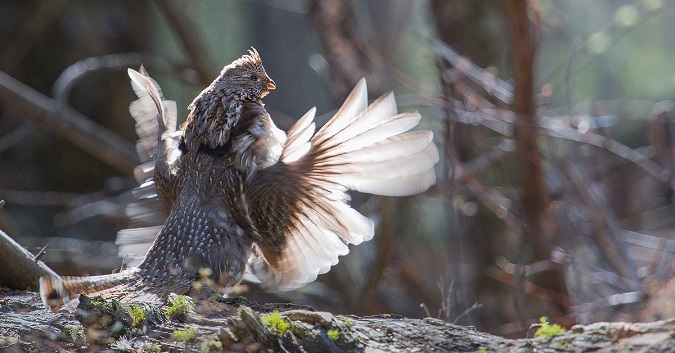
Experienced upland hunters consider the ruffed grouse the most challenging game bird of all. From years of pursuing this beautiful brown, russet and black bird, I can vouch for that. If there’s a way a grouse can flush just when you don’t expect it, get a tree between you and the shot pattern, or veer up, left, right, or down as you squeeze the trigger, this amazing bird will do it.
And that’s not to mention living in some of the roughest, steepest, briar-infested mountain country imaginable—almost as if to challenge our fitness, stamina, and will to pursue it. But when all the hours of walking, flushes heard but not seen, and missed shots culminate in the successful harvest of a grouse, the hard effort will seem worthwhile. And even on those days when you trek tired and sore-legged back to the truck without a bulge in your game pouch, the thrill of pursuing this wary bird that seems to symbolize wildness will still bring a warm glow of satisfaction.
One of the best ways to improve your odds of at least occasionally bagging a grouse is to avoid making mistakes. I feel well qualified to write on this topic. Over many years of chasing grouse in Virginia’s foothills and mountains I have probably made every mistake possible, some of them many times over.
But gradually I began to learn from those mistakes. And as I did, I saw my flushing and bagging rates go up and also my enjoyment of the sport.
I could list countless mistakes I’ve made and seen other grouse hunters make. But these 14 are some of the most common and harmful errors you can commit. Thankfully, most are easy to correct. Being aware of these potential pitfalls ahead of time is often the only help you need avoid making them.
1. Using an inappropriate firearm. This is somewhat subjective, but many grouse hunters use guns that are way too heavy. They also carry guns with barrels too long. Avoid those two mistakes by choosing a lightweight, short-barreled double, semi-autoloader, or pump for your grouse hunting.Heavy guns weigh you down on the long hikes through the hills and mountainous habitat where grouse live. They are also harder to mount quickly and swing on a fast-departing bird when you only have seconds to find the target and fire. Six-and-a-half pounds should be the top weight. Lighter is better still.A long barrel is also a detriment when working through thick, briar-filled cover where grouse like to hang out. It can easily get caught on saplings and vines when you try to mount and fire.
Carry a lightweight 12-28 gauge shotgun in any action you please with a short barrel, for easy swinging in thick cover. I like a side-by-side double, but autoloaders, over-and-under shotguns, and pumps are also good choices.
Avoid a single shot if possible. Sometimes you’ll miss with your first shot but the grouse will still be in range if you had a second shell available. On other occasions two grouse may flush and you won’t have a follow-up shot available for the other bird.
2. Installing the wrong choke. The thick cover these birds inhabit most of the time means shots will be short range—sometimes as close as 10-15 yards, often 20-25 yards.Open or skeet is the best choice for these shots. At times improved cylinder will be okay if the cover is more open, but very rarely will a modified be a good choice. Open patterns also help those of us with modest shooting skills connect more often with their wider patterns.
3. Selecting the wrong shot size. You can also help your success rate by using a small pellet size. That allows more shot to be packed in each shell, meaning a denser pattern.Grouse are fairly easy to bring down with size 8 pellets for early hunting, 7 ½ for late season. If you’re hunting unusually open terrain or it’s late in the season and grouse are flushing far out, 6s can occasionally be a good choice.
4. Moving too fast. It’s natural to want to cover a lot of ground as you search for grouse. But the fact is, you’ll probably walk past a lot of birds if you use that approach. You’ll also become tired more quickly and won’t be able to hunt as long. Fast-moving hunters also tend to blow right past good cover instead of walking it out thoroughly.
The ruffed grouse knows it blends into the leaf-strewn forest habitat and does not like to fly unless it has to. It would much rather sit tight and let you saunter past than fly. If you walk slower, it will unnerve grouse more and make birds flush that would otherwise just hunker down and wait until you’re gone.
By Aldo Leopold, A Sand County Almanac. Continue reading at this link – https://dwr.virginia.gov/blog/avoid-mistakes-collect-more-grouse/
